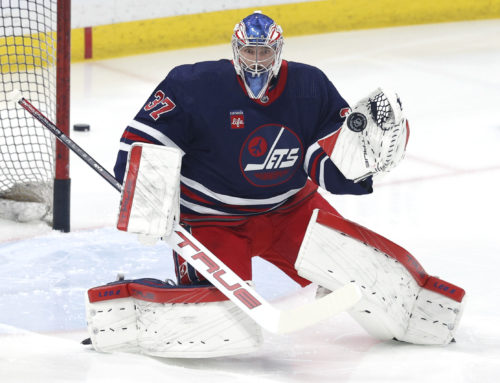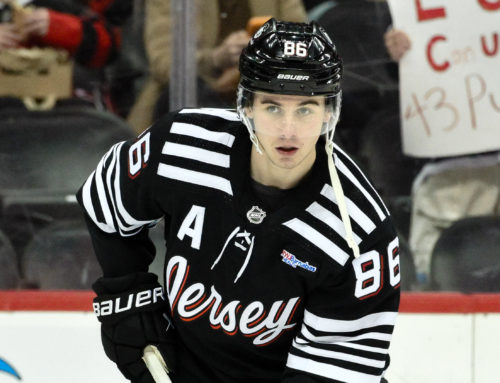Top 10 Players with High IPP
Tom Collins
2024-02-05
If you’re trying to figure out which players may regress post-All-Star festivities, one of the best tools to use is individual points percentage, otherwise known as IPP.
Basically, IPP measures how frequently a player picks up a point on any goal that is scored while that player is on the ice. To make it simple, if a team scores 100 goals when a player is on the ice and that player nets a point on 70 of them, his IPP is 70%.
However, if a player consistently has an IPP between 55-65% for five straight campaigns, and then suddenly jumps up to 85% this year, that player is a good candidate for regression. Even if that player is playing on the top line with superstars, there are only so many points to go around.
Remember, at any one time, the most points that can be scored on a goal is three (the goal scorer, plus potential two assists). This means at five-on-five or on the power play, only 60% of the players on the ice can pick up a point on each goal. If you think of how many goals have only one assist, zero assists or even a goalie assist, and you realize that reaching an IPP of above 50% can be pretty difficult.
To put numbers into context, elite players usually finish between 70% to 80%. Connor McDavid‘s IPP is 77%, Nikita Kucherov‘s is 79.4%, Artemi Panarin's is 76.7%, Elias Pettersson‘s is 71.1%, David Pastrnak's is 80% and Nathan MacKinnon's is 71.8%.
Below are 10 players who have seen an uptick in IPP of at least 10 percentage points this season compared to last year. We’re going to look at IPP and power-play individual points percentage (PPIPP). Keep in mind, that not every player listed will see a regression the rest of this season.
10. William Nylander
It’s interesting to have Nylander on this list, because last week, his linemate John Tavares made the list of Top 10 Players with Low IPP. Nylander started the season as one of the hottest players in the league, which he parlayed into a big-money, long-term contract. He’s on pace for his first 100-point season and he’s taking a wicked-high 4.2 shots per night. He also looks poised to set career highs in power-play points as well. His IPP is 78.2%, up from 67.4%, while his PPIPP is 75.9%, up from 51.9%. His IPP is already starting to drop, as he has only four points in his last nine contests and a 50% IPP in that time.
The Hurricanes center has a bit of a funny history with IPP. Starting in 2019-20, his IPP has gone from 71% to 66.3% to 74.3% to 62.6% to 75% this year. His PPIPP also fluctuates similarly. From a point-total perspective, last year is probably the only one of those campaigns considered to be disappointing for him, as he posted a 73-point pace instead of his usual 80+. Even if his IPP regresses at some point, expect him to continue to put up at least an 80-point pace.
8. Tomas Hertl
The Sharks forward is having a bit of a down season, as he’s only on pace for 58 points, but it seems like the offense is running through him when he’s on the ice. His IPP is 79.1%, an increase of 16.1 percentage points from last year’s 63%, and the second highest of his career (he had an 82.7% in 2020-21). His PPIPP is 75%, up from 62.9% a year ago.
Thomas has been excellent this season. He's on pace for 87 points, up from 73 a year ago, but on par with 2021-22. With 17 goals already, he looks poised to break his career high of 20 goals. His shooting percentage of 17.2% is the same as the previous two campaigns, but he’s now averaging a career high of two shots per contest. Thomas’ IPP this season is 78.8%, a career high, up from 61.3% a year ago. His PPIPP of 71.4% is pretty much on par with last year’s 68.8%.
6. Sam Reinhart
Reinhart is having an outstanding season, and at this rate, could finish as the biggest surprise of the year. He’s on pace for 60 goals and 103 points. He’s already set a career high in power-play goals at 20 (which is seven more than the next closest player), and his 24 power-play points are only seven off his all-time best. He has a crazy high shooting percentage of 27.6%, a significant increase from last year’s 13.6%. His IPP is 78.5%, up from last year’s 59.8%, and his PPIPP is 77.4%, up from 51.9%.
Before the season began, I had Batherson as one of my picks to reach 70 points for the first time. Right now, he’s on pace for 66 points, so just off that mark. His IPP has gone from 62.6% last year to 73.1% this season, a smidgeon off his previous career high of 72.9%. He does get some time with the top power-play unit, which is helping boost his PPIPP from 60.4% to 68.8%.
4. Mark Stone
Maybe the biggest surprise of Stone’s season is that he hasn’t missed a single game yet. That’s a bit shocking considering he normally misses a minimum of 10-20 games per season. So far this year, he has been on the ice for 72.1% of goals scored, up from 61.3% a year ago. His PPIPP is at 58.3%, up from 42.9% in each of the previous two seasons. If this keeps up, he’s on pace for his highest point total in four years.
Sharangovich is a bit of a strange case. Is his IPP better because he’s taking that next step offensively? Is it because he is now on a top-six line with a new team and a new system? Is it because he’s getting more touches with the puck than before? It’s probably a combination of all three. His IPP is 77.8, up from 65.2 a year ago and an all-time high. His power-play jump is even more impressive, as he didn’t score a man-advantage point last year, giving him a PPIPP of zero. This year, he’s getting regular power-play time and has a PPIPP of 77.8%.
JVR is having a bit of a resurgence, on pace for 58 points. This has been a far more productive season than his last two years in Philly, when he had an 82-game pace of 38 and 39 points. Some of that is due to his success on the power-play, where he has 11 points (he had 13 combined the previous two seasons). His IPP on the season is 74.4%, up from 56.9% last year and a career high. Meanwhile, his PPIPP is at 57.9%, up from 40% a season ago.
1. Joel Farabee
Farabee’s 40 points are already one point higher than his previous career high, and he’s at a career-high 2.4 shots per game. He has six power-play points, one off his career high. However, he’s on the second power-play unit, and his 16:05 per night is almost a full minute less than last year. Why is he so productive? His IPP is at 87%, the highest in the league of all players with at least 15 points. His PPIPP is also an astronomical 85.7%. This means his puck luck is through the roof, and he’s a great candidate to see a regression the rest of the season, unless you believe he can continue to get a point on almost nine of every 10 goals scored when he’s on the ice.
One Comment
Leave A Comment
You must be logged in to post a comment.





 BUF
BUF N.J
N.J PHI
PHI MIN
MIN WPG
WPG VAN
VAN TOR
TOR CGY
CGY T.B
T.B
You’d think batherson on top PP would lower his PP IPP, not raise it…playing with better players should usually result in those players having a higher share of the IPP?